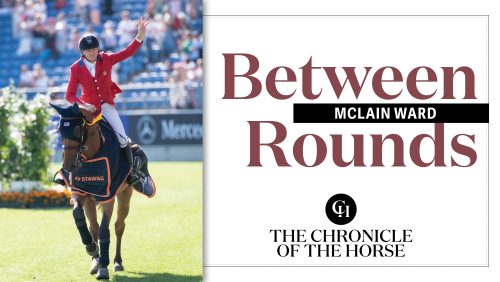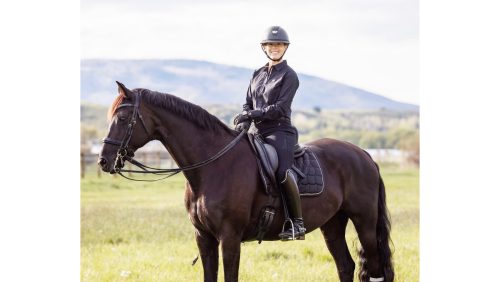Our columnist addresses a variety of topics brought up by the International Dressage Riders Club.
In April, the Fédération Equestre Internationale hosted a Sports Forum in Lausanne, Switzerland, involving all Olympic disciplines. Dressage was naturally on the agenda, and all stakeholders were invited to submit their proposals for things to be discussed.
The International Dressage Riders Club produced an impressive list of agenda items with thought-provoking titles.
While I wasn’t there for the discussions at the forum, I wanted to share some thoughts on the topics. To start out, the question was posed whether or not the FEI World Dressage Championships for Young Horses actually produce performance horses or are just beauty contests for the breeders. There’s no doubt that this form of competition quickly has become popular and has earned a great deal of attention in Europe. But has all the action produced sufficient numbers of horses that go on to perform in the top sport?
That’s still under debate. A related issue is whether the format is appropriate for most horses—or if the program could even be detrimental to the development of horses that aren’t ready for the demands.
In the United States, the beginning of the young horse championships was a bit slow, as with most new projects, but by the time the program reached its 10th anniversary two years ago, it had bloomed into improved quality. It’s now become an attractive event for spectators as well as exhibitors.
I firmly believe our American YHCH programs have a mission to fulfill, even if statistics at the end of the day do not prove that an overwhelming number of the horses that partake or win go all the way to glory in Grand Prix. In reality, how many of all the dressage horses being trained in the world actually reach that level? I’ve had the privilege of judging our young horse championships almost every year since its inception, and it’s one of my absolute favorite tasks.
Since I’ve followed the program, I have a clear view of its progress. Two years ago, there was a definite jump in the quality of horses in all divisions. Suddenly there was no horse that looked out of place. They all looked like contenders, and our work to sort them out became more difficult and more exciting.
This year there was yet another upswing in quality, and now the top horses in the 4- to 6-year-old divisions could show up anywhere in the world and impress the spectators with their power and grace.
Another thing happened this year: The riding was vastly improved. In the past, there were times when one would wish to see a certain horse ridden differently to enhance him more. I don’t recall one such comment being made in our judges’ box this year. We would make suggestions on some “detail work” here and there, but the overall sophistication in the presentation of the youngsters was awesome.
The riders did not push the 4-, 5- or 6-year-olds beyond their capacity but showed them off within their comfort level. They were all in the right place in the bridle with proper positioning of the neck and a consistent contact.
A great deal of the credit for the uniform riding goes to Scott Hassler, our USEF Young Horse Dressage Coach, who was available to help the riders at ringside for the entire event. Except for an occasional “green” moment, the horses were very comfortable in their skins, and most of the riders are our next generation of FEI competitors.
It didn’t hurt that the weather for the finals was glorious, and the venue, Lamplight Equestrian Center in Wayne, Ill., polished beyond belief and featuring brand new footing. The intimate yet functional atmosphere of Lamplight is perfect for these championships: horse friendly and inviting for the audience with many pavilions that allow for viewing the event.
ADVERTISEMENT
Another major reason for the success of this program, however, is the consistent and generous sponsorship from Markel Insurance.
Perhaps we need the Young Horse program even more in the States than they do in Europe because it provides a much-needed focal point and destination for our dedicated young trainers, breeders and owners of young horses. Our country is so vast, and we fight that problem all the time.
To get back to the IDRC question of over-facing the horses, I feel the riders and owners have figured out by now that this route is not for every horse but reserved for the gifted ones who can deal with life in the fast lane.
What’s News?
Another hot topic on the riders’ list: the modern media and its impact on our shows and warm-up methods. Is the media our friend or foe?
I was studying to become a journalist when no social media, blogging or Internet existed, so to me, the whole thing tends to seem out of control. When anybody can express anything at all, recklessly report unchecked information, and instigate without repercussions, the media is not a positive force. Without any editing or checking for facts, sometimes even without an identified author, there is little value in the “news” that pours out from these sources—and no protection for the targets of sometimes unwarranted and personal attacks.
To refute anything tossed out on the Internet is virtually impossible. Nobody pays attention to the rebuttals; everybody is too busy taking in the new “news.” Patrik Kittel was a victim of this for a long time, and the hysteria that ensued over videos taken of him while schooling, although it could stand criticism, was out of proportion to the “crime.” Two years later, he was still a target at the Olympic Games, and there is no end to these kinds of things once they get rolling.
Proper journalism that requires accountability for what is put out there is becoming a lost art form. Every blogger seems out to promote himself in some way, and how that is going to help our sport in general is hard to see.
Luckily, there are still some old-fashioned reporters active in the field who check their facts and sources and report in an ethical way, but I fear it’s a dying breed. As the magazines and periodicals disappear into websites, and the electronics swallow their work, it will be more and more difficult to discern the difference between truth and propaganda.
Declining Respect For Judges
A discussion on judges took form under the title “Who died and made you king?” I hope that doesn’t sum up the attitude of the competitors toward the people who spend endless hours concentrating on and analyzing their work.
The scrutiny of our judges continues to evolve. In the last 10 years or so the FEI has added open scoring, the creation of a judges’ supervisory panel at all championships, greatly improved and intensified the training of our FEI judges, and even started a system to remove judges who do not officiate regularly. By cleaning up in the ranks and offering more refresher courses, the FEI aims to keep judges active and current, which promotes more accurate and consistent judging. So far, so good.
In the meantime, the judges are the least paid and least appreciated officials in the entire sport.
ADVERTISEMENT
Gone are the days when judges were viewed as worthy of respect because of their amassed knowledge. Today, in spite of the enormous and sometimes unrealistic demands on their results, dressage judges are sometimes barely tolerated by organizers and treated by the dressage community as a necessary evil.
This development is not healthy. Judging is truly a labor of love, and every person who does it for years on end has a huge heart for the sport and a great respect for the riders.
In July, Carl Hester wrote a commentary in Horse & Hound about the situation of the judges, which drew a lot of attention to the problem, since it came from an absolute top competitor. When it was suggested to Carl that he become a judge, he said he sees no motivation to attempt that job, however qualified and beneficial to the sport his officiating may be. He frankly states that between meager pay, little respect, few perks and lots of pressure, staying a trainer appears the way to go. So much for drawing our top competitors to the judge’s box!
Olympic Status
Yet another heading with spice was: “Olympic Status: Friend or Foe?” Having been in the roles of spectator, horse owner and coach at various Olympics I can answer this question from several angles. I’ve also taken an active part in four World Equestrian Games and found each one delightful from the point of view that it was all about horses, and the focus was clear.
When it comes to Olympics, everything multiplies and becomes more complicated and more intense in every way. The many sports and many venues interacting worked well in London in 2012, and the horse facility was outstanding and centrally located. This is not the norm for Olympics where the horses are often relegated to some remote area completely separated from the rest of the action, as happened in Hong Kong in 2008.
That is, to me, the worst of all worlds: Olympic pressure and expectations without any of the benefits of being in the middle of the action.
I’m also well familiar with the extra pressure that comes with the Olympic atmosphere. For all the talk about the importance of participating and it’s “how you play the game,” in the end it really is all about medals!
Participating in the Olympics changes some of our game plans by making our sport adjust to the overall picture of the qualifying process, which can become very complicated and stressful for the competitors, the federations and committees who deal with the details of the process. The FEI Dressage Committee is already deeply involved with planning the route to Brazil 2016.
Nevertheless, and in spite of all the complications, I’m certain that equestrian sports will fight to stay in the Olympics. The commercial and “fame” value, as well as the possibility of gaining sponsorship and financial aid increases considerably when attached to an Olympic label.
And then there is this: Ask any aspiring child rider what her dream is, and instantly you get the response: To ride in the Olympics!
Anne Gribbons was the U.S. Equestrian Federation technical advisor for dressage from 2010-2012. She has trained and shown 15 horses of her own to Grand Prix and competed in 10 national championships as well as in Europe, including the Aachen CHIO (Germany). Seven of her horses have been U.S. Dressage Federation Horse of the Year, and she was a member of the 1995 Pan American silver medal-winning team for the United States. Anne is a Fédération Equestre Internationale five-star judge, and she’s been a member of the FEI Dressage Committee since 2010. She started contributing to Between Rounds in 1995.














